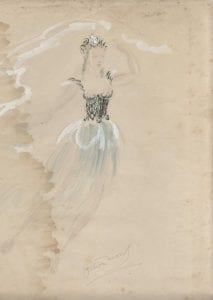One of the things I love about volunteering at the Theatre Collection is handling some of the artefacts held in its keeping. Yes, it can be a little chilly when working in the temperature-controlled strongroom, but as my mum used to say, I can ‘don a thermal vest‘.
Lately, in the more balmy surroundings of the reading room, I’ve been working through boxes of the Oliver Messel Archive, undertaking biographical research of his associates. I’ve gained knowledge about some of the 20th century’s notable personae and insight into Messel himself. A man I hadn’t heard of before I started working with the material – and there is plenty of material! He didn’t seem to throw much away but we’re richer for it.
Amongst myriad papers, there is treasure: yellowing press cuttings; black and white photographs of Bogart and Bacall, printed telegrams and letters (glorious, handwritten letters that Messel and his friends exchanged). Handwriting is becoming a dying art and it’s wonderful to see this tangible connection and imagine a pen – or pencil – scuffing across paper. Messel demonstrated that a well thought-out response, even in disagreement, carried more weight than a vitriolic key-bashed Tweet. He also came across as a man of principle and a couple of items in particular reveal this.
Firstly, a letter he wrote to Kay Graham of the Washington Post. In January 1977, the newspaper published an article about Theodore R Britton Jnr, the first black American ambassador in the Caribbean. It claimed Britton was being, “probed on incompetence charges.” Messel, then resident in Barbados, did not like the tone or content and sent a delightful riposte, praising the ambassador’s achievements. He was also unequivocal about why, in his view, Britton was being investigated: “…You cannot convince me that there has been no racial motivation in all of this from the start; of course there has! Envy that a man who is black should be in a coveted position, that he should also have compelling charm and intellect.”
A second example illustrated that Messel’s loyalty extended beyond his acquaintances. In September 1970 the Performing Arts Council Transvaal, wrote to him about mounting a production of Sleeping Beauty in Johannesburg. They requested use of costumes and décor that Messel had designed for the production when it was performed at Covent Garden.
I almost whooped, ‘Good man, Oliver!’ when I read Messel’s reply. His firm refusal was from the heart. Referring to the poisonous regime of apartheid, he made clear that there weren’t any circumstances in which he would accede to the request. ‘I could not wish to accept any hospitality from a country whose laws and principles are to me so utterly abhorrent.’ He continued, ‘that you all live blind-folded through the selfish greed of a white minority appears tragically short-sighted.’ He was, he said, ‘revolted by separate audiences.’
I’ve discovered that the Messel Archive isn’t only about what one man left behind. It’s also a glimpse of what was happening in the world: what’s changed and, unfortunately, what hasn’t. I wish I could have met him, though what he’d have thought about my thermal vest, I can only guess.
By Natalie Smith

